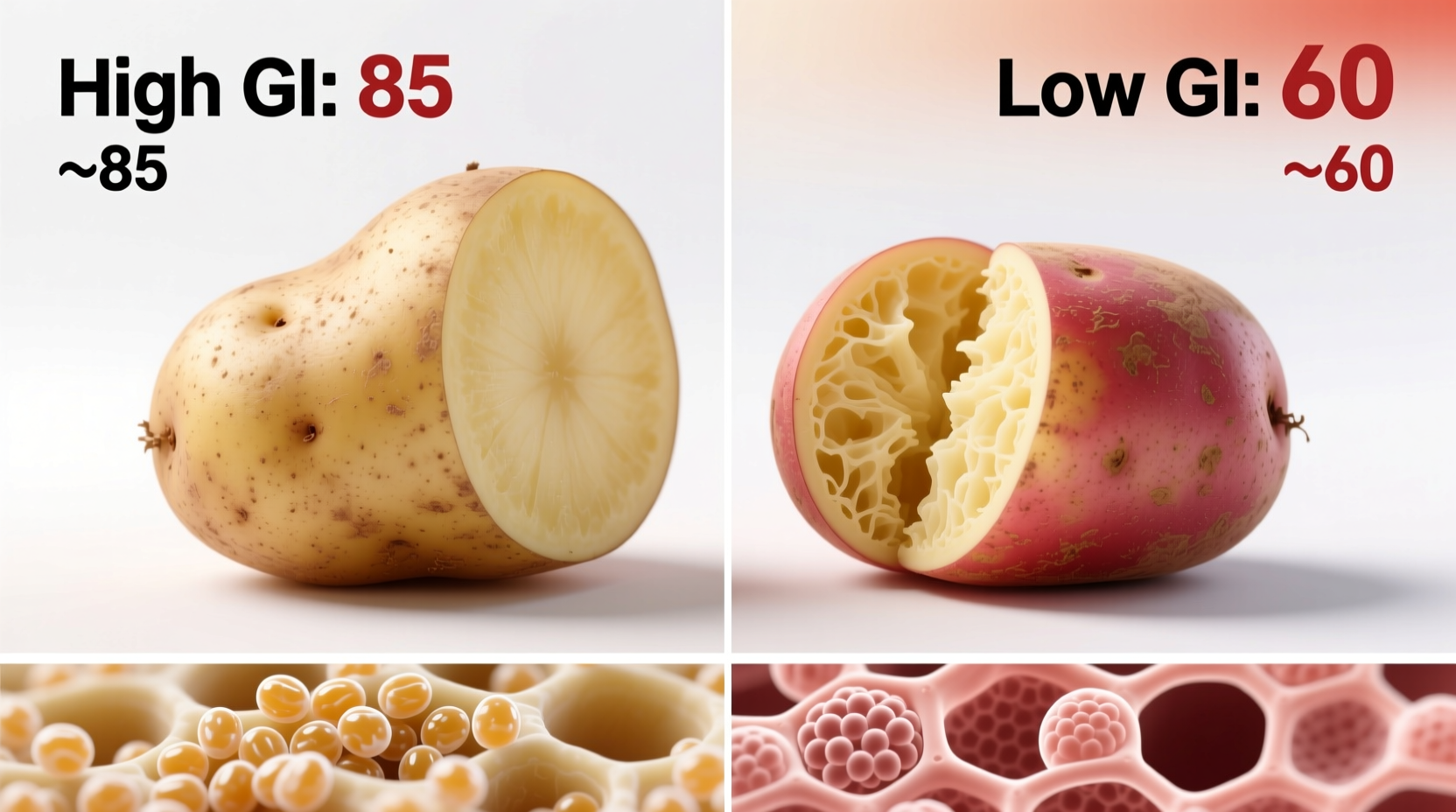Boiled white potatoes typically have a glycemic index (GI) of 78-85, placing them in the high-GI category. However, cooling potatoes after cooking can reduce their GI by 20-25% due to resistant starch formation. Sweet potatoes generally have a lower GI (44-60), making them a better option for blood sugar management.
Understanding the glycemic index of potatoes is crucial for anyone managing blood sugar levels or making informed dietary choices. Potatoes are a staple food worldwide, but their impact on blood glucose varies significantly based on type, preparation method, and what they're eaten with. This comprehensive guide provides evidence-based information to help you make smarter potato choices without sacrificing flavor or nutrition.
What Exactly Is Glycemic Index and Why It Matters for Potatoes
The glycemic index measures how quickly carbohydrate-containing foods raise blood glucose levels compared to pure glucose (which has a GI of 100). Foods are classified as:
- Low GI: 55 or less
- Medium GI: 56-69
- High GI: 70 or above
Potatoes generally fall into the high-GI category, but this isn't the whole story. The specific GI value depends on multiple factors including potato variety, cooking method, and what other foods accompany them in your meal. For people with diabetes or insulin resistance, understanding these nuances can make a significant difference in blood sugar control.
Potato Varieties Compared: GI Values at a Glance
| Potato Variety | Preparation Method | Glycemic Index | Glycemic Load (per 100g) |
|---|---|---|---|
| Russet (White) | Boiled | 85 | 22 |
| Red Potatoes | Boiled | 89 | 19 |
| White Potatoes | Baked | 93 | 27 |
| Sweet Potatoes | Boiled | 44 | 11 |
| Carisma (White) | Boiled | 53 | 14 |
| Yukon Gold | Boiled | 78 | 19 |
Data sourced from the University of Sydney's Glycemic Index Database, considered the most comprehensive and scientifically validated GI resource globally. Note that these values represent averages; actual GI can vary based on specific growing conditions and preparation techniques.
How Cooking Methods Dramatically Alter Potato Glycemic Impact
The way you prepare potatoes significantly affects their glycemic response. Here's what research shows:
- Cooling potatoes after cooking: Creates resistant starch, lowering GI by 20-25%. A study published in the European Journal of Clinical Nutrition found that cooled boiled potatoes had a GI of 56 compared to 78 when served hot.
- Boiling vs. Baking: Boiled potatoes generally have a lower GI than baked potatoes. Baking breaks down more starch, making it more readily digestible.
- Adding fat or acid: Consuming potatoes with vinegar, lemon juice, or healthy fats can slow gastric emptying and reduce the blood sugar spike.
- Whole vs. mashed: Whole potatoes typically have a lower GI than mashed potatoes due to less starch gelatinization.

Practical Strategies for Including Potatoes in Blood-Sugar Friendly Diets
You don't need to eliminate potatoes from your diet entirely. These evidence-based strategies can help minimize their glycemic impact:
- Choose lower-GI varieties: Carisma and certain sweet potato varieties offer significantly lower GI values than standard white potatoes.
- Cool before eating: Allow cooked potatoes to cool completely in the refrigerator before consuming to increase resistant starch content.
- Pair strategically: Combine potatoes with protein (chicken, fish, beans) and healthy fats (olive oil, avocado) to slow glucose absorption.
- Portion control matters: A small serving (½ cup) of high-GI potatoes has less impact than a large serving of medium-GI potatoes.
- Consider the meal context: Eating potatoes as part of a balanced meal with non-starchy vegetables significantly reduces the overall glycemic load.
When Potatoes Might Be Appropriate (and When to Limit)
Understanding the context boundaries for potato consumption is essential for personalized nutrition:
- Appropriate for active individuals: Athletes and highly active people can benefit from the quick energy provided by higher-GI potatoes, especially when consumed around workout times.
- Problematic for insulin resistance: People with type 2 diabetes or prediabetes should be more cautious with standard white potatoes, particularly when eaten alone or in large portions.
- Meal timing considerations: Potatoes may be better tolerated at lunch than at dinner, as metabolic rate typically slows in the evening.
- Individual variation: Continuous glucose monitoring studies show significant person-to-person variation in glycemic response to identical potato meals, highlighting the importance of personal experimentation.
Potatoes vs. Other Common Carbohydrate Foods
Putting potatoes in context with other carbohydrate sources helps make informed choices:
- White rice: Typically has a GI of 73 (white) to 50 (brown), making some rice varieties comparable to or even higher than certain potatoes.
- Bread: White bread averages GI 75, while whole grain bread ranges from 50-60.
- Pasta: Most pasta varieties have lower GI values (40-50) than potatoes due to the physical structure of cooked pasta.
- Legumes: Beans and lentils generally have very low GI values (20-40), making them excellent alternatives for blood sugar management.
According to the American Diabetes Association, focusing on the overall meal pattern rather than individual foods provides the best approach for blood sugar management. Potatoes can fit into a balanced diet when consumed mindfully and in appropriate portions.
Frequently Asked Questions About Potato Glycemic Index
Do all potatoes have a high glycemic index?
No, not all potatoes have high glycemic index values. While standard white potatoes typically range from 78-85 on the GI scale, certain varieties like Carisma white potatoes (GI 53) and boiled sweet potatoes (GI 44-60) fall in the medium to low categories. The preparation method also significantly affects the final GI value.
Why do cooled potatoes have a lower glycemic index?
Cooling cooked potatoes triggers the formation of resistant starch, a type of carbohydrate that resists digestion in the small intestine. This resistant starch passes to the large intestine where it's fermented by gut bacteria, resulting in a slower, more gradual release of glucose into the bloodstream. Research shows cooling boiled potatoes for 24 hours in the refrigerator can reduce their glycemic index by 20-25%.
Are sweet potatoes always better than white potatoes for blood sugar control?
Generally yes, but preparation matters. Boiled sweet potatoes typically have a GI of 44-60, making them a better option than most white potatoes (GI 78-85). However, baked sweet potatoes can reach GI values as high as 94, potentially exceeding some white potato varieties. For optimal blood sugar management, choose boiled sweet potatoes over baked ones and consider portion sizes.
How much potato can I eat if I have diabetes?
The appropriate portion depends on individual factors including your overall meal plan, activity level, and blood sugar response. As a general guideline, the American Diabetes Association suggests limiting starchy vegetables like potatoes to ½ cup cooked per meal (about the size of a computer mouse). Pairing potatoes with protein and non-starchy vegetables helps minimize blood sugar spikes. Using continuous glucose monitoring can help determine your personal tolerance.
Does the glycemic index tell the whole story about potatoes' nutritional value?
No, the glycemic index is just one aspect of a food's nutritional profile. Potatoes are rich in potassium, vitamin C, and fiber (especially with skin). The glycemic load (which considers portion size) often provides a more practical measure than GI alone. Additionally, factors like cooking method, what the potatoes are eaten with, and individual metabolic responses all influence the actual blood sugar impact.











 浙公网安备
33010002000092号
浙公网安备
33010002000092号 浙B2-20120091-4
浙B2-20120091-4